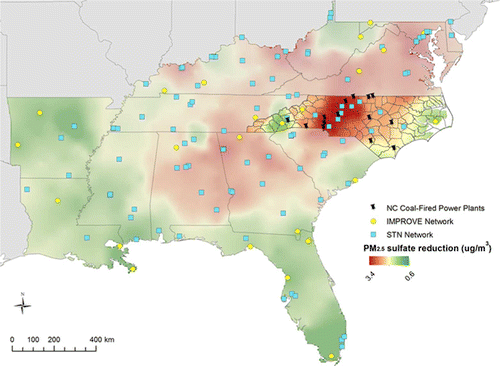Lowering coal-fired power plant emissions may have saved 1,700 lives in one year

After scoring a Supreme Court victory this spring, the Environmental Protection Agency can move forward with its strategy to cut air pollution from coal-fired power plants in several states—and new research suggests the impact could be lifesaving. Scientists assessed the effects of one state's prescient restrictions on plant emissions in a report in the ACS journal Environmental Science & Technology. They estimated that the state's legislation prevented about 1,700 premature deaths in 2012.
Jacqueline MacDonald Gibson and Ya-Ru Li explain that the U.S. has been working for years to lower levels of particulate matter, a form of air pollution that can cause serious health problems when people breathe it in. Certain kinds of particulate matter form mainly from power plant emissions. More than 10 years ago, correctly anticipating the federal government would eventually set tighter restrictions on power plants, North Carolina had approved more stringent goals than neighboring states. It required 14 major coal-fired plants within its borders to reduce emissions of nitrogen oxides and sulfur dioxides by 60 percent and 72 percent, respectively, over a 10-year period. Gibson's team wanted to see what effect the measures were having.
They found that the policy had successfully reduced emissions in North Carolina more than other southeastern states. Sulfur dioxide levels, for example, dropped an average of 20 percent a year from 2002 to 2012. Across all southeastern states, they dropped 13.6 percent per year. As a result of the improved air in North Carolina, the scientists used a health impact model to estimate that about 1,700 lives were saved in 2012 alone.
More information: "Health and Air Quality Benefits of Policies to Reduce Coal-Fired Power Plant Emissions: A Case Study in North Carolina" Environ. Sci. Technol., 2014, 48 (17), pp 10019–10027. DOI: 10.1021/es501358a
Abstract
We analyzed sulfur dioxide (SO2) emissions and fine particulate sulfate (PM2.5 sulfate) concentrations in the southeastern United States during 2002–2012, in order to evaluate the health impacts in North Carolina (NC) of the NC Clean Smokestacks Act of 2002. This state law required progressive reductions (beyond those mandated by federal rules) in pollutant emissions from NC's coal-fired power plants. Although coal-fired power plants remain NC's leading SO2 source, a trend analysis shows significant declines in SO2 emissions (−20.3%/year) and PM2.5 sulfate concentrations (−8.7%/year) since passage of the act. Emissions reductions were significantly greater in NC than in neighboring states, and emissions and PM2.5 sulfate concentration reductions were highest in NC's piedmont region, where 9 of the state's 14 major coal-fired power plants are located. Our risk model estimates that these air quality improvements decreased the risk of premature death attributable to PM2.5 sulfate in NC by about 63%, resulting in an estimated 1700 (95% CI: 1500, 1800) deaths prevented in 2012. These findings lend support to recent studies predicting that implementing the proposed federal Cross-State Air Pollution Rule (recently upheld by the U.S. Supreme Court) could substantially decrease U.S. premature deaths attributable to coal-fired power plant emissions.
Journal information: Environmental Science & Technology
Provided by American Chemical Society
















